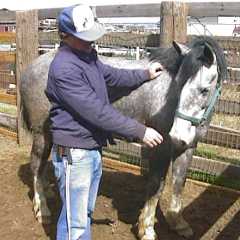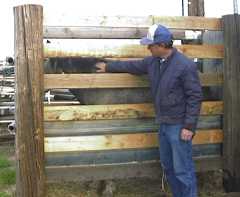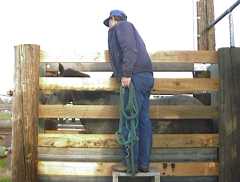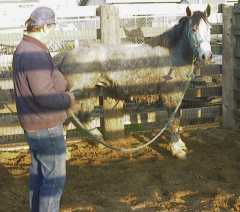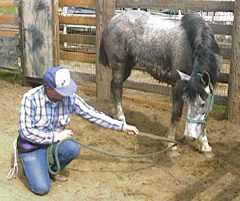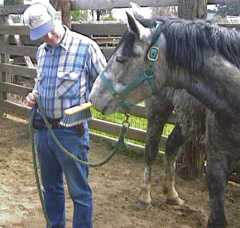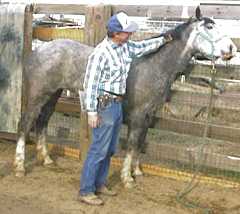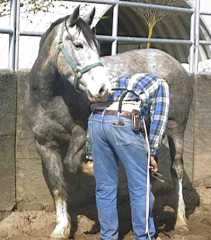|
|
|
OPERANT BEHAVIORAL ISSUES
|
We can either confine, coerce and control the horse; force him
against his will, or we can use the horse's natural instincts
to follow and learn and develop a willing, working partner.
When bad stuff happens, the rider is much better off with a mount
who wants to follow and has a high degree of respect than one
who is merely looking to escape the rider's confining and oppressive
presence.
The principles of natural horsemanship are designed around
exploiting the horse's natural instincts and developing his
beneficial characteristics. In many horses this process is
relatively easy. They are curious and the horseman employs
some herd leadership games in which the horse invests his interest
and curiosity. If the horseman is competent, the horse becomes
a willing follower.
However some horses come with baggage which inhibits this response.
They may be raised in the wild and have a deep seated inhibition
with respect to letting a predator into their personal space. Horses
may have learned fears due to some prior bad experiences or trauma.
They may have aggressive tendencies, perhaps are simply spoiled or
may have been so sheltered that they never learned to process their
environments and make non-reactive decisions as to how to deal with
unexpected encounters.
One or more of these characteristics create impediments to learning.
Fear can create it's own stress-feedback loop; the fear building upon
itself when the horse is being worked while in an anxious state.
Some horses respond to stress by becoming unfocused. These animals
don't pay attention, overreact to stimulus and are poor learners.
Other horses may be spooky, failing to process their surroundings then
suddenly reacting when they finally observe an object which now is
only a short distance away. Some horses simply don't like being
handled, perhaps as a result of some bad prior experience. A few
horses display more than one of these traits.
The clicker becomes useful as it interdicts these destructive
processes and focuses the horse in a more beneficial manner. Having
a positive conclusion to each step in the click learning process
gives the horse a chance to be right, start to see value in the
interaction, and eventually start using his cognitive abilities
in order to try to figure out the game and win a reward.
Obviously the clicker requires oral gratification in order to
start producing results, however once the horse is desensitized to
the presence of the human and the training process, he can start
to process other forms of positive reinforcement from soothing
scratches to verbal praise.
We were afraid that the use of treats would encourage the horse
to mug us for carrots. What we discovered was that if the handler
is disciplined and only gives treats following a click, the horse
won't look for the reward until after the click is sounded.
We tried an experiment with a very hyperkinetic mare we call
"Whoa Nellie" which Sharon had spent just a few minutes teaching
the "Touch it!" game. Sharon held a target on one side and I stood
on her other side with a handful of carrots. The horse could
reach around any time to grab the carrots from me but her attention was
on Sharon. When she cued, "Touch it!" the mare would touch the
target then immediately swing her head over to me and take a
piece of carrot out of my hand following the click. Horses have a great capacity for
figuring out such simple and interesting games.
Thus the click precedes any treats and the horse tries to earn
a click.
The design of the clicker is perfect. It's easily held and its
sound is unique and distinctive, unlike any other sound in the
horse's field of hearing. It takes only a few repetitions for
the horse to associate the click with a treat reward.
The click can be sounded the instant the horse achieves the
objective without the handler generating some visual distraction.
The ability to time the click at the proper instant makes the
objective more understandable to the horse.
The clicker is distinctive. Humans are usually so verbal that the
horse generally accepts our conversation as background noise and
when verbally addressed, has to decide, "Was that cue or feedback
intended for me?" The click is clear and unmistakable and that is
why it works so well.
Once the horse understands the association, the handler needs to
set up a very simple exercise that the horse can easily figure out
in order to establish the premise that the horse must do
something for the click to occur. Once this association is
established, the handler slightly increases the difficulty of
the objective so the horse starts to reason out the changes which
are occurring and curiously tries to determine what he needs to
do to earn the click. Once you get that association down, the
results that you can obtain are virtually limitless.
| 
